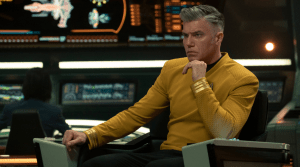Rogue One: A Star Wars Story gave fans plenty of thrills but one of the most surprising things to happen in the movie was the appearance of Grand Moff Tarkin, a prominent character from the original 1977 Star Wars. In the original film, Tarkin was played by legendary actor Peter Cushing, who sadly died in 1994. Through incredibly advanced CGI and with permission from the Cushing estate, the filmmakers were able to digitally bring the actor back to life to play a main character in the film. The technology is so advanced that Lucasfilm has even gone on record to say that they won’t be using the technique to bring Carrie Fisher’s Leia Organa to life for Star Wars Episode IX.
Videos by ComicBook.com
Despite the advances in technology making the feat more believable than ever, Rogue One is hardly the first time filmmakers have had to use Hollywood magic to bring an actor who has passed away to life. The techniques might have changed, but dealing with the real-world passing of an actor when a multi-million dollar production rested squarely on an actor’s shoulders has been handled in a variety of ways.
Do you think it’s okay for filmmakers to resurrect actors for their films or do you think it’s disrespectful? Let us know in the comments!
READ MORE: Rogue One: A Star Wars Story Had Alternate Plan For Tarkin / Star Wars: Actor Who Played Moff Tarkin in Rogue One Revealed / Star Wars: See How Tarkin Came to Life in Rogue One Special / ILM Was Excited and Terrified to Create Digital Tarkin
Bela Lugosi – Plan 9 From Outer Space
Ed Wood is arguably the most famous of all B-movie directors, who spared every expense imaginable to get his stories on the screen. Plan 9 has a reputation for its poor plot, acting, and effects, but it also has the notoriety of being Bela Lugosi’s last film. Even more interesting is the fact that rumors suggest the scenes in which Lugosi appears were intended for two different films entirely, but when the actor passed away, Wood recycled the footage to get a Lugosi credit in the film. The two scenes make little sense in regards to the rest of the plot, so Wood employed a chiropractor to be a stand-in for Lugosi, despite them baring no resmblance, something Wood covered up by making the character constantly cover his face with a cape.
[H/T YouTube/Cablogula]
Bruce and Brandon Lee – Enter the Dragon/The Crow
Tragically, the father and son acting team both passed away while in the middle of filming two different movies. Bruce passed away while filming Enter the Dragon, but most of the film had been completed so the production finished through the use of editing and body doubles. The Crow was meant to be a breakout hit for Bruce’s son Brandon, but due to a misfire of a prop gun, shrapnel flew from the barrel and fatally killed the up and coming star. Despite the production woes, The Crow used similar body double and editing techniques to finish the film, which has gone on to be a cult classic that spawned three sequels and an upcoming remake.
[H/T YouTube/War God Sports]
Oliver Reed – Gladiator
Legendary actor Oliver Reed suffered a fatal heart attack while filming Ridley Scott’s epic Gladiator, but most of his scenes had been shot. Advances in computer technology had gotten so sophisticated that, rather than recast or scrapping the character, Scott made a few rewrites for Reed’s character and used CGI to superimpose Reed’s face on a body double in hopes of giving the actor a proper send-off. The success of the technique paved the way for the technique and showed how effectively the technique could be used in future films.
[H/T YouTube/atomicfirehead]
Heath Ledger – The Imaginarium of Doctor Parnassus
Heath Ledger died in January of 2008, which compromised a couple of movies. Released later that summer, The Dark Knight‘s ending was reworked to give Ledger’s character a more definitive ending, as he clearly couldn’t be in future installments. However, almost all of his scenes had been shot, so it was just a matter of some editing to give the actor a proper finale. Terry Gilliam’s The Imaginarium of Doctor Parnassus relied heavily on Ledger’s star power for funding, so when he died having only filmed some of his scenes, Gilliam thought the project would be scrapped. Instead, thanks to the experimental nature of the story, Gilliam enlisted Jude Law, Colin Farrell, and Johnny Depp to portray Ledger’s character, with his transformations throughout the picture being justified by the story.
Paul Walker – Furious 7
During a break from filming Furious 7, Walker tragically died in a car accident, throwing production into jeopardy. The cast had a difficult time coping with a beloved costar, and considering the success of the series, it was hard for the filmmakers to back out of production completely. The film ended up undergoing serious delays, but through a combination of rewrites, editing, and superimposing Walker’s face onto his real-life brothers acting as stand-ins, Furious 7 was completed successfully. The delays in filming also allowed the story to give Walker’s character an appropriate send-off for the beloved actor, with characters paying their respects, and those emotional beats helped the film set a record for the fastest a filmed earned $1 billion worldwide in just 10 days.
[H/T YouTube/The Folan]









